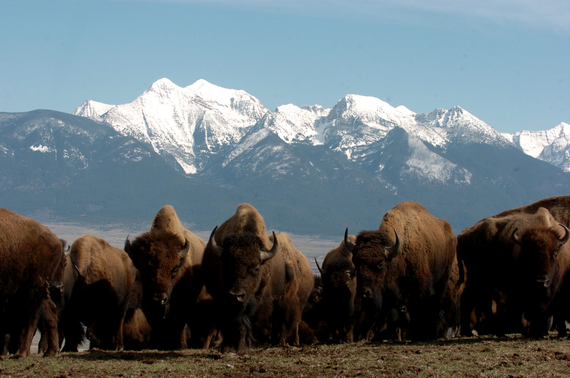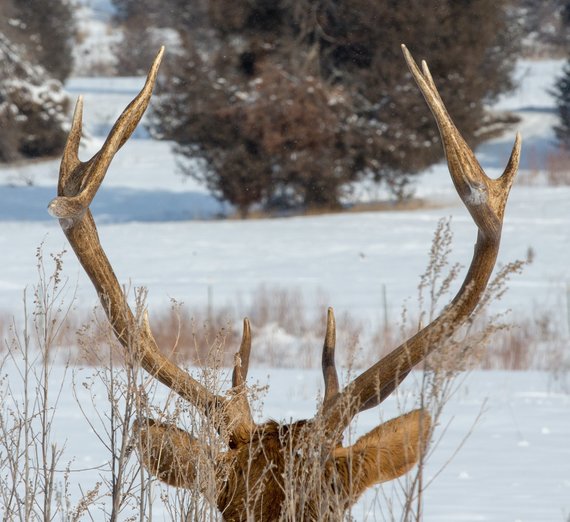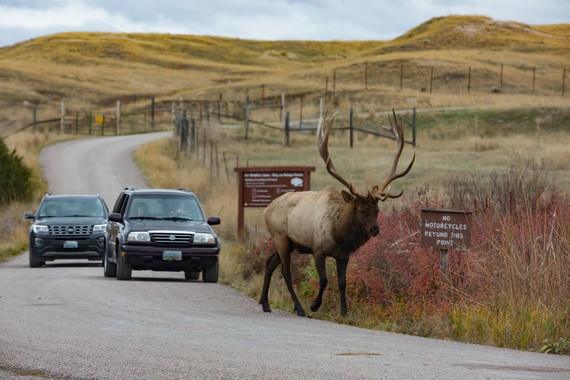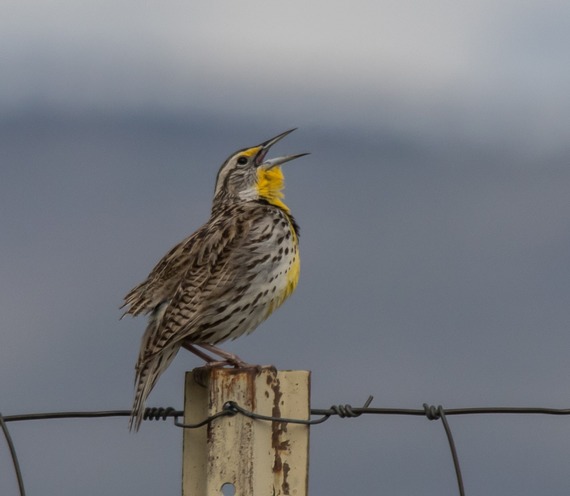|

Volume 3 - April 2019
The U.S. Fish and Wildlife Service, as part of its ongoing efforts to plan for the future of the National Bison Range, recently announced a 45-day public comment period and three public meetings for the national wildlife refuge’s draft Comprehensive Conservation Plan (CCP) and associated Environmental Impact Statement (EIS).
We are seeking public comments on the draft CCP/EIS from April 5 to May 20. Public comments can be submitted via email to scoping_NBR@fws.gov or by postal mail to: Bernardo Garza, U.S. Fish and Wildlife Service, Branch of Planning and Policy, 134 Union Boulevard, Suite 300, Lakewood, Colorado 80228.
Following the public comment period, the Service will analyze comments received, publish a final CCP/EIS, and make a final determination about the preferred management alternative for implementing the CCP.
Once finalized, the CCP will determine resource management and visitor recreational goals, including public use and access, for the National Bison Range over the next 15 years.
Read below for additional information, updates, and public involvement opportunities.
 A herd of bison on the National Bison Range in Montana. Photo: USFWS
We (the U.S. Fish and Wildlife Service) are excited to announce that the draft Comprehensive Conservation Plan (CCP) and Environmental Impact Statement (EIS) for the National Bison Range (refuge) is now available for public review and comment. The draft CCP/EIS addresses the significant issues we, our partners, and the public identified during the planning process. We invite you to engage in the public review of the draft CCP/EIS.
This planning update provides an overview of the contents of the CCP/EIS. The entire draft CCP/EIS is available for viewing or downloading on our website:
https://www.fws.gov/mountain-prairie/refuges/nbrc.php
We will hold public meetings on April 30, May 1, and May 2. Please refer to the meetings schedule at the end of this update for more details.
The draft CCP/EIS analyzes three alternatives for managing habitat and wildlife, visitor services, operations, and other important values and resources. We appreciate your continued involvement in the CCP development process and look forward to talking with you about the issues and addressing your comments. The comment deadline is May 20, 2019. Additional information about how to provide your comments is located at the bottom of this planning update.
The purpose of this draft CCP/EIS is to identify the role the refuge will play in support of the mission of the National Wildlife Refuge System (Refuge System) and to provide long-term guidance for management of refuge programs and activities.
The CCP seeks to:
- provide a clear statement of direction for management of the refuge
- provide neighbors, visitors, and government officials with an understanding of the Service’s management actions on and around the refuge
- ensure that the Service’s management actions are consistent with the mandates of the National Wildlife Refuge System Improvement Act (Improvement Act)
- ensure that management of the refuge considers other federal, tribal, state, and local government plans
- provide a basis for prioritizing allocation of funding and staffing levels across National Bison Range programs (e.g. visitor services, law enforcement, management, biology)
- recognize and address, as appropriate, National Bison Range’s location within the Flathead Indian Reservation and address the refuge's importance to the tribes and the communities within the Mission Valley of Montana
We are committed to sustaining the Nation’s fish and wildlife resources together through the combined efforts of governments, businesses, and private citizens.
Based on the many refuge qualities and issues identified, and recommendations provided during the scoping process, as well as guidance from the Improvement Act, the National Environmental Policy Act (NEPA), and the Service’s planning policy, we addressed the following significant topics in the draft CCP/EIS:
- Habitat Management
- Bison Management
- Wildlife Management
- Tribal Cooperation/Cultural and Historic Resources
- Visitor Services
- Socioeconomics
- Operations and Staffing
- Partnerships/Communication
- Monitoring and Research
Early in the process, we granted cooperating agency status to the following agencies, and we have valued their input throughout the planning process:
- Bureau of Indian Affairs
- Confederated Salish and Kootenai Tribes (CSKT)
- Montana Fish, Wildlife and Parks
- Lake and Sanders Counties
 A view through the antlers of a large bull elk at the National Bison Range in Montana. Photo: Dave Fitzpatrick/USFWS
We developed a vision for the entire National Bison Range Complex at the beginning of the planning process. The vision describes the focus of National Bison Range Complex management and portrays a picture of the National Bison Range Complex in 15 years. As a unit of the refuge complex, the vision statement below sets the context for the future for the National Bison Range.
“Relax and take a deep breath while you step back in time to reflect on what was, what is and what is yet to come. Immerse yourself in the intermontane valleys of northwestern Montana shaped by glacial forces and steeped in rich cultural history. This is a special landscape important to people age after age, where we pay tribute to the persons and peoples who set aside the lands, conserved the wildlife and plants, and were stewards of various components that make up the complex. Visitors from all over the world travel to the National Bison Range Complex which seeks to provide an opportunity to learn and experience varied habitats, abundant wildlife and the natural beauty of these lands. The units of the Complex safeguard these values and preserve connectivity across the landscape, forming continuity through time for future generations to treasure. Each
unit is unique, and collectively they have, and will continue, to contribute to the Complex and the Refuge System. Partners foster cultural and natural resources conservation where the cultural history is expressed across the landscape. Unique opportunities to work with partners benefit many of the units within the Flathead Indian Reservation and other units located within traditional homelands of the Salish, Upper Pend d’Oreille, and Kootenai Tribes.”
We developed eight goals for the National Bison Range based on the Improvement Act, the purposes for each unit of the National Bison Range Complex, and information developed during the planning process. The goals focus work towards achieving the vision and purposes of the refuge and outline approaches for managing refuge resources. Goals were developed for:
- Habitat Management
- Wildlife Management
- Research and Science
- Monitoring and Adaptive Management
- Cultural Resources
- Public Use
- Partnerships and Collaboration
- Administration and Operations
 Elk at the National Bison Range in Montana. Photo: Dave Fitzpatrick/USFWS
Following the scoping process in 2017, we held meetings and workshops with the cooperating agencies and identified a range of preliminary alternatives. After sharing these preliminary alternatives with the public, we considered additional suggestions from the public and revised the alternatives. Some of the preliminary alternatives were changed or combined into the alternatives presented in the draft CCP/EIS. In concert with existing refuge plans, these alternatives examine different ways in which we can address significant issues and achieve the goals.
Elements Common to All Alternatives
Regardless of the alternative selected, we will comply with all applicable laws, regulations, and policies for management activities on the refuge, such as bison donations, prescribed fire, protection of archaeological and historical sites, as well as staff and visitor safety.
In addition, we would continue to collaborate with our partner agencies and organizations in order to share information (e.g. existing resource plans, traditional ecological knowledge, new research, best management practices, etc.) and collaborate with the CSKT and other Tribes in developing relevant educational and interpretive materials.
The refuge would continue to sell the refuge specific pass, as well as the America the Beautiful passes, the Federal Duck Stamp, and the Junior Duck Stamp.
The Division of Refuges in the Service’s Mountain-Prairie region developed a Realignment Strategy in 2016 to guide the future staffing of all refuges in the 8-state region. All alternatives proposed in the draft CCP/EIS have been developed within the framework of the Realignment Strategy.
Alternative A—Current Management
Under this alternative, we would continue all the current management activities while maintaining funding, infrastructure, all programs, and staffing with few changes. The Service’s NEPA handbook states that the no action alternative is where current conditions and trends are projected into the future. Because Alternative A represents the current, unchanged refuge management, it may not meet every aspect of every goal.
Alternative B
This alternative emphasizes managing habitat, wildlife populations, and refuge infrastructure and operations to provide quality, wildlife-dependent opportunities for the public. All programs on the National Bison Range would seek to foster public support and appreciation for the resources of our land and our waters. We would maximize the quality of recreational opportunities by providing improved access, facilities, interpretive materials, and environmental education. We would also aim to enhance the quality of the public’s experience by maintaining healthy wildlife populations and habitats that support activities such as wildlife observation, photography, interpretation, education and fishing. Working with partners, through existing and new partnerships, is also a key component of this alternative.
Alternative C—Proposed Action
This alternative emphasizes maintaining and, where feasible, enhancing ecological communities while recognizing ever-changing environmental conditions. In cooperation with our partners, we would develop and utilize a prioritization framework to identify and define future conditions that will drive management actions to build ecological community resiliency, promote species and genetic diversity, and build sustainability in management capacity and operations. Under this alternative, we would seek to facilitate collaborative, cooperative, and coordinated management of National Bison Range with our federal, tribal, state, local, public, and private partners. Where possible, refuge personnel would participate in landscape-level management of wildlife species, evaluate cross-boundary movements, and create corridors conducive to wildlife migration and movement. We would also seek ways to incorporate the expertise, resources, and efforts of our partners to help facilitate the benefits of a broader functioning landscape. Wildlife-dependent public uses and programs would continue at near current levels.
The draft CCP/EIS will be available for a 45-day public review period. The document can be viewed at or downloaded from the planning website: https://www.fws.gov/mountain-prairie/refuges/nbrc.php
You can request a hardcopy of the draft CCP/EIS by sending an email to scoping_nbr@fws.gov.
We are seeking the input of the public, our conservation partners, and federal, tribal, state and local governments. We ask that all comments be provided to us by May 20, 2019. You may provide your comments in person during one of the upcoming public meetings (see below), or in writing via postal service or email at the address below.
When reviewing the draft CCP/EIS, keep in mind that comments should be specific and address the document’s adequacy, the impact statement, or the merits of the alternatives. In the final CCP/EIS, we will respond to all substantive comments that:
- provide additional information relevant to the analysis
- question, with reasonable basis, the accuracy of information in the document
- question, with reasonable basis, the adequacy of the environmental analysis
- offer reasonable alternatives other than those in the draft document
- cause changes or revisions to the draft CCP/EIS
Before including your address, phone number, email address, or other personal identifying information, you should be aware that your entire comment—including your personal identifying information—may be made available to the public at any time if so requested from the Service.
While you can ask us in your comment to withhold such information, we cannot guarantee that we may be able to do so.
The alternatives, the impact analysis, or other features of the draft document may be changed as a result of the comments received during the review. After the draft document has been revised, a final CCP/EIS will be published, which will identify the preferred alternative.
The Service’s final decision will be documented in an official ROD to be published in the Federal
Register, no sooner than 30 days after filing the ROD with the U.S. Environmental Protection Agency and distributing it to the public.
 Meadowlark at the National Bison Range in Montana. Photo: Dave Fitzpatrick/USFWS
Send email comments to:
Scoping_NBR@fws.gov
Or mail written comments to:
National Bison Range
Comprehensive Conservation Plan
Attn: Bernardo Garza, Planning
P.O. Box 25486
Denver, CO 80225-0486
Tel 303/236 4377; 303/236 4792
We will host three open-house public meetings that will include brief presentations at 6:00 p.m. on the planning process and on draft documents for which we are seeking comments. We invite all attendees to arrive anytime between 5:00 p.m. and 8:00 p.m. to meet with members of the Planning Team and provide us with your input.
Date: April 30, 2019
Time: 5:00 p.m. - 8:00 p.m.
Location: Missoula Public Library
Address: 301 E Main St. Missoula, MT 59802
Venue Phone: 406/721 2665
Date: May 1, 2019
Time: 5:00 p.m. - 8:00 p.m.
Location: Red Lion Inn
Address: 209 Ridgewater Dr. Polson, MT 59860
Venue Phone: 406/872 2200
Date: May 2, 2019
Time: 5:00 p.m. – 8:00 p.m.
Location: National Bison Range Visitor Center
Address: 58355 Bison Range Rd Moiese, MT 59824
Venue Phone: 406/644 2211
Bernardo Garza and Vanessa Fields, Planning Team Leaders
U.S. Fish and Wildlife Service
Division of Refuge Planning
P.O. Box 25486
Denver, CO 80225-0486
Email: bernardo_garza@fws.gov or vanessa_fields@fws.gov
Phone: (Bernardo) 303-236 4377; (Vanessa) 406-217 6473
Fax: 303-236-4792
National Bison Range Refuge Complex
Address: 58355 Bison Range Rd, Charlo, MT 59824
Phone: 406 -644-2211
Fax: 406-644-2661
|